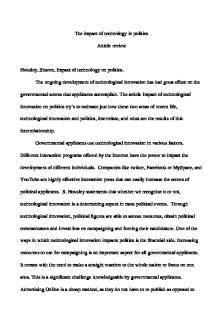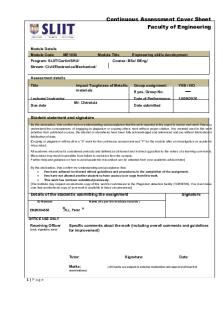Impact of a jet PDF

| Title | Impact of a jet |
|---|---|
| Course | Fluid mechanics |
| Institution | جامعة العلوم والتكنولوجيا الأردنية |
| Pages | 6 |
| File Size | 267.9 KB |
| File Type | |
| Total Downloads | 96 |
| Total Views | 160 |
Summary
Impact of a jet experiment ...
Description
Jordan University of scince and Technology Factuly of Engineering Mechanical Engineering Department Thermofluid Lab
Exp 2 . impact of jet
Objective Abstract Introduction Theory procedure data Results and calculations discussion Conclusion
Name : Heba Saleh Aljhani
20.2.2019
\
: Objective
determine the reaction force produced by the impact of jet of water on to variety type .1 .of target vanes Measurement of the impact force on fl at and hemispherical plates and comparison .2 with momentum change Measurement of the impact force on an angled fl at plate and conical plate (available .3 separately) and comparison with momentum change experimentally determine the force required to keep a target at a datum level while it is .4 subjected to the impact of water jet, and the experimentally measured force is compare . with the theoretical calculated force
:Abstract The objective of this experiment is to determine the reaction force produced by the impact of jet of water on to variety type of target vanes, to experimentally determine the force required to keep a target at a datum level while it is subjected to the impact of water jet, and the experimentally measured force is compare with the theoretical calculated .force
: introdution To understand correctly how a turbine (a Pelton wheel for example) works, students need to understand how jet defl ection produces a force on turbine vanes. They also need to know how this force infl uences the rate of momentum fl ow in the jet. This product shows students the force produced by a jet of water as it strikes a fl at plate or hemispherical cup. They can then compare this to the momentum fl ow rate in the jet. To extend the range of investigations, the 120-Degree Conical Plate and 30-Degree Angled Plate (H8a) are available separately. TecQuipment’s hydraulic bench (H1F, available separately)* provides the water source for experiments. The Impact of a Jet consists of a transparent cylinder containing a vertically tapered nozzle and a test plate. The cylinder is on legs and mounts on the top of the hydraulic bench. The nozzle, supplied by the hydraulic bench, produces a high-velocity jet of water which hits the test plate. The test plate connects to a weigh beam assembly with jockey weight which measures the jet force. A drain tube in the base of the cylinder directs water back into the hydraulic bench, allowing accurate fl ow rate measurement. All test plates are all easily interchangeable, taking only a few seconds and needing no tools. To perform experiments, students level the apparatus and zero the weigh beam assembly. They set the fl ow from the hydraulic bench to maximum, and measure the jet force. They reduce the fl ow from the hydraulic bench in several increments. At each increment they record the force of the jet on the plate and the fl ow rate. They then repeat the experiments for diff erent test plates. Students compare their experimental results to those calculated from theory, working out . charts of rate of force on plate and rate of delivery of momentum
: Theory
Water turbines are widely used throughout the world to generate power. In the type of water turbine referred to as a Pelton† wheel, one or more water jets are directed tangentially on to vanes or buckets that are fastened to the rim of the turbine disc. The impact of the water on the vanes generates a torque on the wheel, causing it to rotate and to develop power. Although the concept is essentially simple, such turbines can generate considerable output at high efficiency. Powers in excess of 100 MW, and hydraulic efficiencies greater than 95%, are not uncommon. It may be noted that the Pelton wheel is best suited to conditions where the available head of water is great, and the flow rate is comparatively small. For example, with a head of 100 m and a flow rate of 1 m3 /s, a Pelton wheel running at some 250 rev/min could be used to develop about 900 kW. The same water power would be available if the head were only 10 m and the flow were 10m3 /s, but a different type of turbine would then be needed. To predict the output of a Pelton wheel, and to determine its optimum rotational speed, we need to understand how the deflection of the jet generates a force on the buckets, and how the force is related to the rate of momentum flow in the jet. In this experiment, we measure the force generated by a jet of water striking a flat plate or a hemispher
Procedure : The apparatus is first levelled and the lever brought to the balanced position (as indicated by the tally), with the jockey weight at its zero setting. Note the weight of
the jockey, and the following dimensions: diameter of the nozzle, height of the vane above the tip of the nozzle when the lever is balanced, and distance from the pivot of the lever to the centre of the vane. Water is then admitted through the bench supply valve, and the flow rate increased to the maximum. The force on the vane displaces the lever, which is then restored to its balanced position by sliding the jockey weight along the lever. The mass flow rate is established by collection of water over a timed interval. Further observations are then made at a number reducing flow rates. About eight readings should suffice. The best way to set the conditions for reduced flow rate is to place the jockey weight exactly at the desired position, and then to adjust the flow control valve to bring the lever to the balanced position. The condition of balance is thereby found without touching the lever, which is much easier than finding the point of balance by sliding the jockey weight. Moreover, the range of settings of the jockey position may be divided neatly into equal steps. The experiment should be run twice, first with the flat plate and then with the hemispherical cup. and compare the results with the computed momentum flow rate in the jet.
Data:
Discussion: We were doing this experiment on two kinds of jet, that are flat plate (with θ=0o ) and hemispherical vane (with θ=180o ), we can see that the force could be found from two
methods, experimentally and theoretically methods, from this we can see that these two values very close to other, and in our calculations we can notice that the distance for balance (y) increasing with increasing the mass flow rate for both plate and this is true because we need longer arm to balance the force from the coming flow rate. Also we can notice the jet force increasing with increasing the flow rate for the same reason above in order to balance the coming force from the water. It can see clearly that mass flow rate, jet force and the distance X is doubled for the hemisphere head and this is because the effect of (θ) in the equation. From figure there are no big errors between theoretical and experimental date for both flat plate and hemisphere. experimental force Theoretical force flat force hemespher force For both cases the force on either flat plate or hemispherical cup is linear with mass flow rate which is called rate of delivery for the water jet, the relation between this shown in the above figure. Moment in both cases is different because the net force acting is different. For fluids, which are, moving in more complicated motions, for example in pipe or in jet, uses the momentum balance equation for their forces. The momentum balance form will be very convenient for solving fluidflow problems. In particular, if will allow us to find out something (force, velocity…etc.) about complicated flows through a system without having to know in detail what goes on inside the system.
Conclusion As a conclusion, the calculated force is correlated with the measured force. Both of the forces will have directly proportional relation. Theoretically, the calculated force should be the same as the measured force. However, this cannot be achieved experimentally due to the errors made during the experiment. From this experiment, the flow rate for the hemisphere is found to be the lowest and thus require a longer time for the volumetric tank to rise....
Similar Free PDFs

Impact of a jet
- 6 Pages

BAB I Impact of Jet Kel 20
- 30 Pages

West Jet HRM Case - Caso West Jet
- 24 Pages

The Crash of Valu Jet 592
- 3 Pages

Impact of humble leadership on
- 20 Pages

Impact of technology in politics
- 4 Pages

Negative impact of social media
- 14 Pages

Jet Momentum - lab assignment
- 15 Pages
Popular Institutions
- Tinajero National High School - Annex
- Politeknik Caltex Riau
- Yokohama City University
- SGT University
- University of Al-Qadisiyah
- Divine Word College of Vigan
- Techniek College Rotterdam
- Universidade de Santiago
- Universiti Teknologi MARA Cawangan Johor Kampus Pasir Gudang
- Poltekkes Kemenkes Yogyakarta
- Baguio City National High School
- Colegio san marcos
- preparatoria uno
- Centro de Bachillerato Tecnológico Industrial y de Servicios No. 107
- Dalian Maritime University
- Quang Trung Secondary School
- Colegio Tecnológico en Informática
- Corporación Regional de Educación Superior
- Grupo CEDVA
- Dar Al Uloom University
- Centro de Estudios Preuniversitarios de la Universidad Nacional de Ingeniería
- 上智大学
- Aakash International School, Nuna Majara
- San Felipe Neri Catholic School
- Kang Chiao International School - New Taipei City
- Misamis Occidental National High School
- Institución Educativa Escuela Normal Juan Ladrilleros
- Kolehiyo ng Pantukan
- Batanes State College
- Instituto Continental
- Sekolah Menengah Kejuruan Kesehatan Kaltara (Tarakan)
- Colegio de La Inmaculada Concepcion - Cebu







